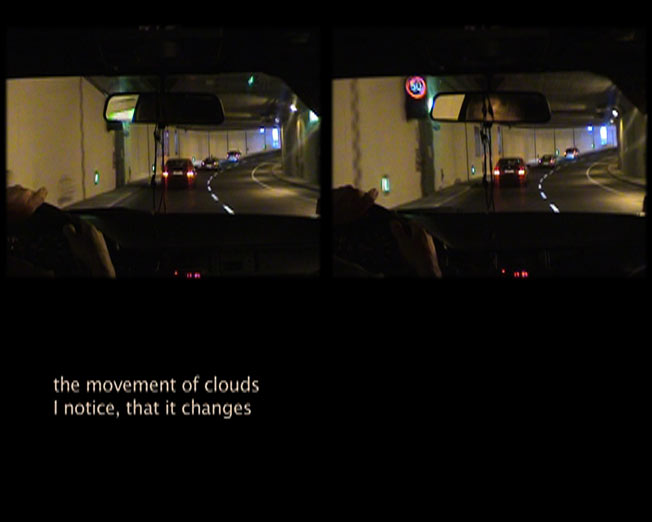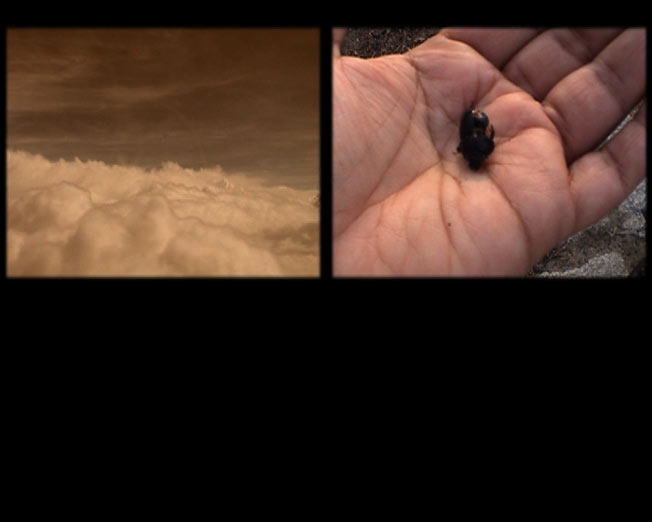
a video-based project.
Sonia Khurana 2006/ 2007
How to tell a story without telling a story.
How to tell a story that keeps changing.
How to unfurl a moment in time, while keeping it intact.

-----------------------
‘Five visits’ is a narration of a moment in time; a magical encounter, the proverbial meeting between two strangers: myself and Tom.
In narrating this moment, ‘five visits’ does not attempt so much to provide a chronological overview. Instead, this abstract narration reconstitutes parts of individual pieces that are personal and dis-engaged at once. As Tom and I attempt to create and then recreate a form and a script for our narrative, our poetic meanderings reinforce an abstract sense of place, that wishes to dip in and out of fiction and fantasy.
----------------------
some snippets:
“There are fifty thousand taxi drivers in Berlin”, Heiko Sievers at the Goethe Institute in Delhi tells me.
“Twenty five percent of the adult population of Berlin is without employment”, my friend Tom tells me.
2001. Arriving in Berlin on the 12th of September; it is yet early to register the full import of the earth-shaking events elsewhere in the world. In a state of sweet oblivion, I irresistably fall in love with the city. In the same instant - almost as divine retribution - my wallet is stolen in Alexander Platz.
This is followed by the tedium of trying in vain to retrieve my silly loss, an at some point, in a state of near-exhaustion, which is compounded by asthma, I decide to hail a taxi. After getting in to the taxi, I realise that I have practically no money. I keep jumping up nervously, to check at the meter. After a while the taxi driver turns around and says mildly: “Don’t worry, this is not a Delhi taxi.”
This is funny, I think. I suppose I need mirth to counter the gloom [although, soon it becomes apparent that humor was not intended..]
I try to converse with the taxi driver, who is not particularly interested in conversing.
But I persist with banter.
“Why do you say that about taxi drivers in India. Have you ridden taxies in Delhi?” I ask.
“No, but my teacher was Indian.” He says.
“So what did you learn.”
“All kinds of things … alternative therapy. Reflexology, indigenous medicine … it’s a long time ago, I lived with my teacher for six years.”
“Tell me more about him, who was he?”
“It does not matter. He left India a long time ago, for fifty odd years he lived in England.”
“Where in England?”
“In London.”
“Please tell me his name.” I say.
“Look, it‘s not important. He died.” He says.
“When did he die?”
He says: “Why do you ask?”
“Please tell me his name!”
My strong premonition is confirmed as he turns around in irritation and answers: “His name was Shyam Singha.”
Slowly, I tell him that Shyam Singha was my uncle.
In a stunned silence, the taxi driver pulls the taxi in a curb and shuts off the taxi meter, while he kept the engine running.
“Listen, we should talk …” we both say, almost at the same time

context:
The back-drop for my video essay is the moment of two simultaneous encounters five years ago: the first encounter was with the city of Berlin and the second encounter, at the same time, was with Tom, who drives a taxi in the city of Berlin, and who has since become a friend.
My simultaneous perceptions of Berlin and of Tom have symbolic and metaphoric overtones; I develop these as counterpoints, and my visits to the city increasingly become a personal travelogue as the search for the subjective.
Beyond and above the notions of architecture, territory and identity, which I feel are omnipresent throughout the city of Berlin, there is always the presence of this magical, almost spiritual encounter with Tom.
Tom was the long-term disciple and spiritual inheritor of my late uncle, who was a renowned healer and self-proclaimed ‘guru’ for alternate and spiritual healing practice, and somewhat of a cult figure in the northern Europe. With his sudden death, Tom’s spiritual and medical enlightenment had been severed midway, and he had since been going through life in Berlin as it came.
For Tom, meeting me and being able to talk about his state of being, became ultimately therapeutic.
To me, not only did meeting Tom save me in a moment of crisis, it also brought about something close to a spiritual experience.

Over the year, my sporadic visits to Berlin have continued. With each visit, and with exchanges with Tom, our friendship has changed form and equation, as well as layers of enquiry: of what lies beneath our ‘skins’ has deepened... Gradually, the attempts to translate the complexity of this experience through one’s work has become more and more compelling.

treatment:
The telling of the story oscillates between art and story telling and cinematic essay and perhaps something else.
[ : There is an ongoing quest in my work which is about the impossibility of embodying [other] spaces [cities]. While looking at the city of Berlin, my perspectives are strongly influenced by my experience of Tom’s situation: I romanticize him as my spiritual other: a somewhat-lost, stoic healer, who drives a taxi, in a near-bankrupt Berlin, during the nights, for a living, spends most evenings ruminating while he waits for customers, and as he drives his customers from Hermannplatz, to HurenHausen, he is worries about keeping his cab occupied and warm in winters in a cold cab, and he worries about getting enough patients to keep his skills as an alternative-healer alive…
As Tom and I continue to meet in the present moment, it is hard to I try to understand the position of Tom-as-a-maverik in his (western) set-up. What for me began as a somewhat spiritual quest, has become a strange cross-over between fiction and fantasy. It is as though through the making if ‘five visits’ I can make the two of us ‘coverse’ in an abstracted sense of time and place.
I like to think that in my work I privilege sense over meaning. Tom turns this around; he wishes his portrait to be non-sensical...